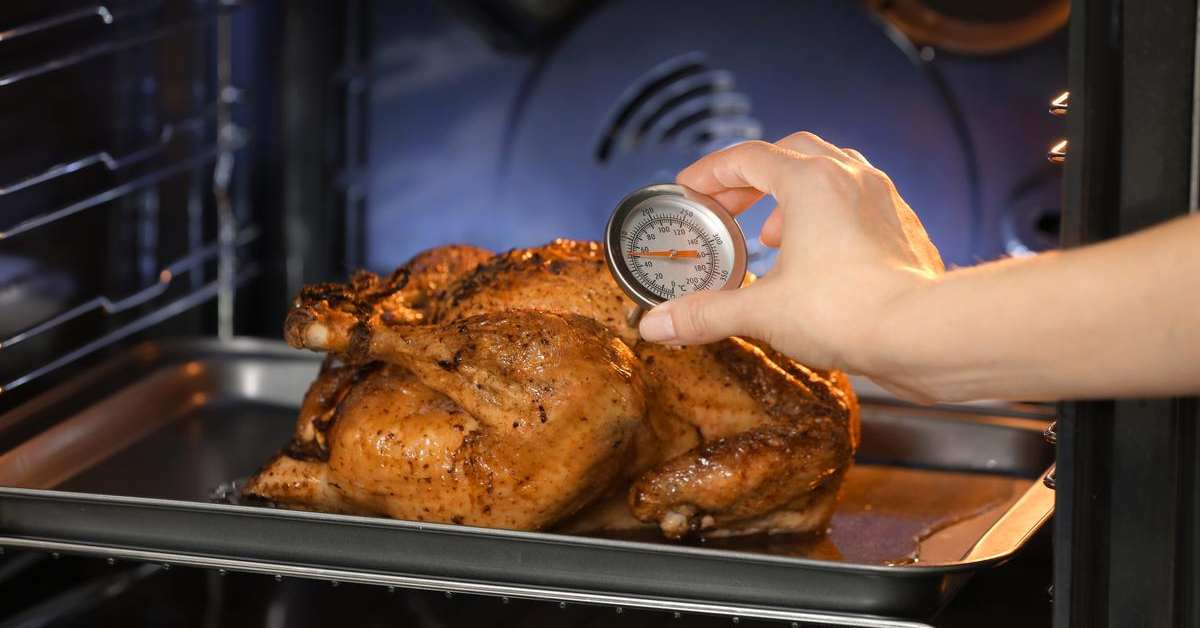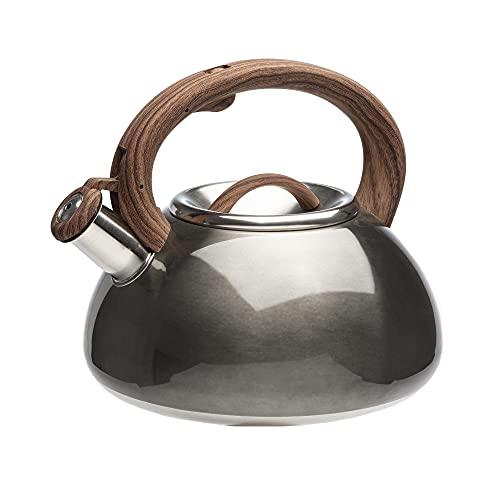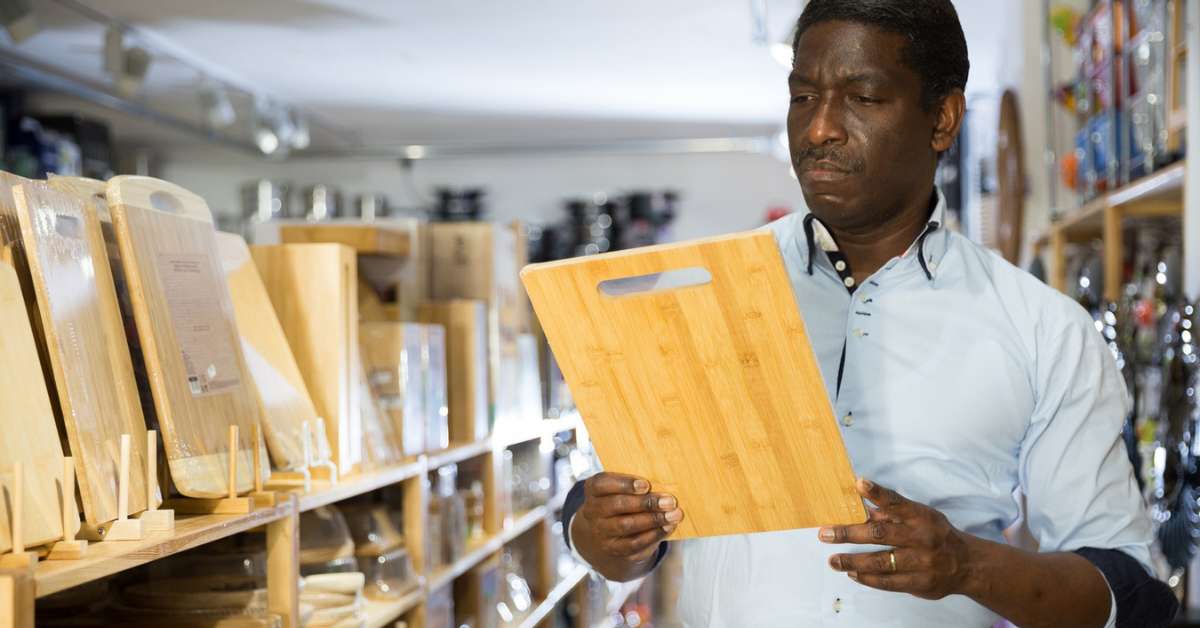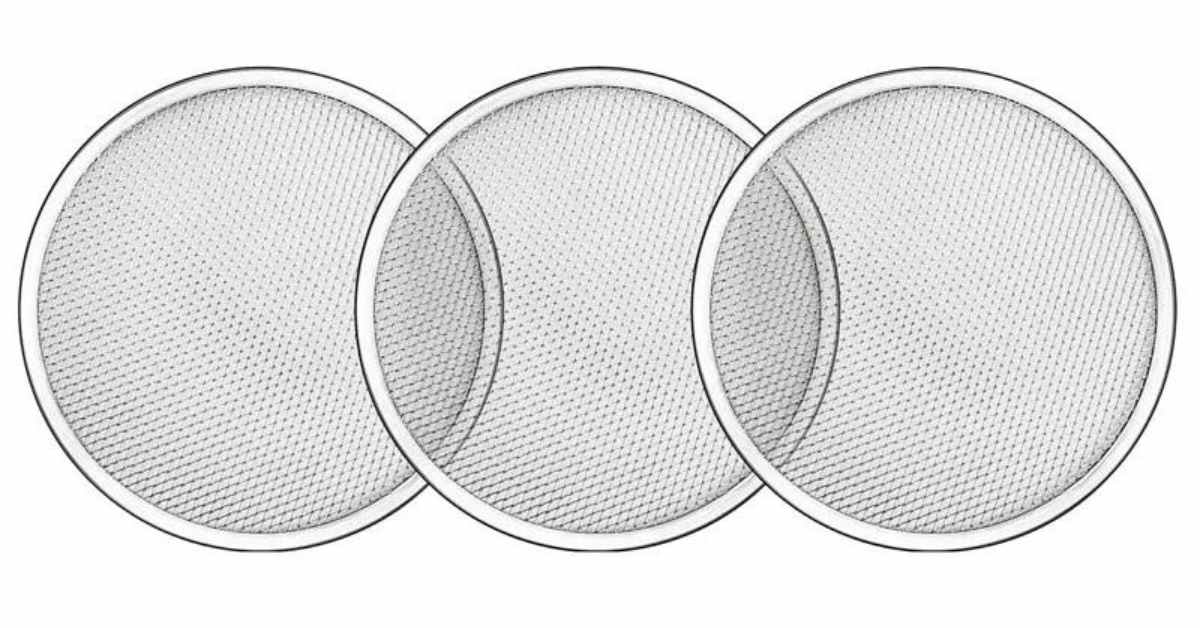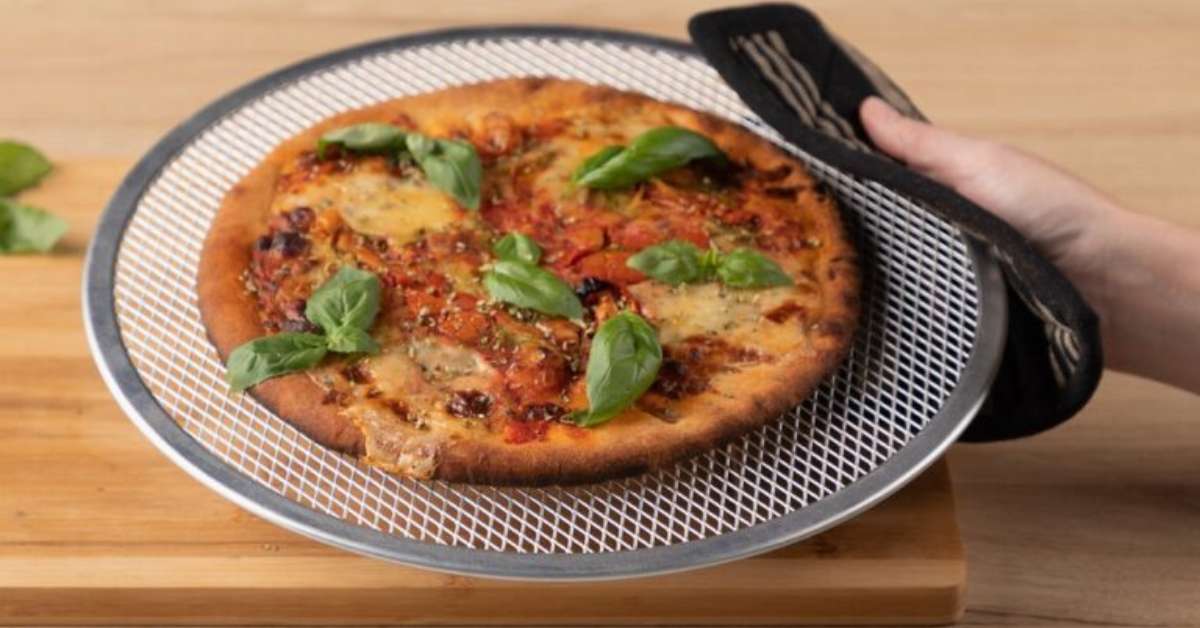Welcome to our blog post, where we’ll delve into an essential culinary query: Can you safely leave a meat thermometer in the oven? As home cooks and chefs alike, we often find ourselves seeking convenient ways to ensure our dishes are cooked to perfection, and a meat thermometer is an invaluable tool for achieving that.
However, whether it’s safe to keep the thermometer inside the oven during the cooking process has sparked some debates. In this article, we’ll provide expert insights and guidelines to help you make an informed decision, ensuring both the delectable flavors of your meals and the safety of your cooking practices.
Table of Contents
ToggleWhat is the Meat Thermometers
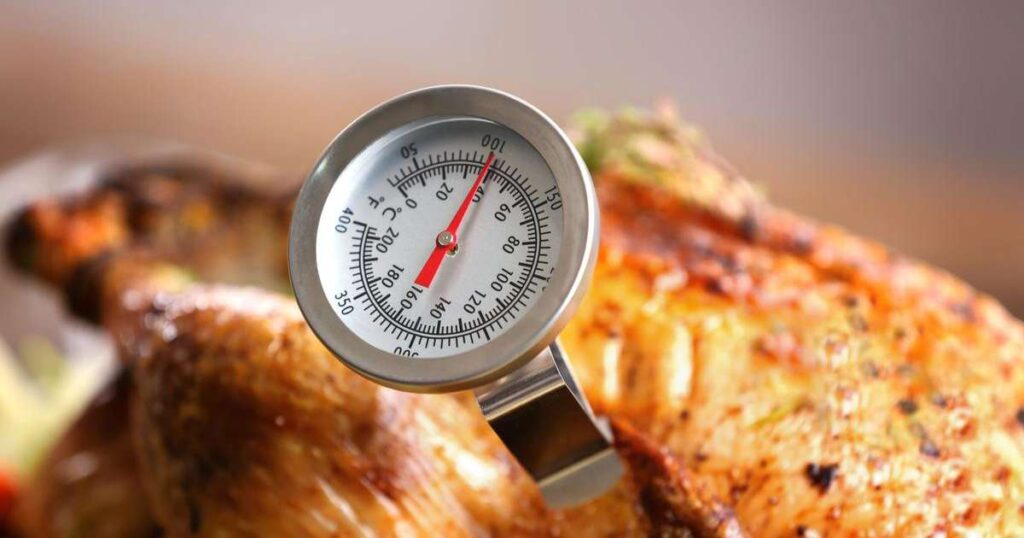
Before we venture into the safety aspects of leaving a meat thermometer in the oven, let’s first understand what it is and why it is a kitchen essential. A meat thermometer is a specialized tool designed to accurately measure the internal temperature of cooked meat, poultry, or fish.
It consists of a metal probe attached to a display unit that shows the temperature reading. The search is inserted into the thickest part of the meat during cooking, and within seconds, it provides us with an instant and precise temperature reading.
A meat thermometer is a crucial ally in the kitchen, particularly when cooking meats, where achieving the right temperature is essential for taste and safety. It helps us avoid undercooking, leading to foodborne illnesses, or overcooking, resulting in a dry and less flavorful dish. This nifty gadget empowers us to cook confidently and finesse by providing real-time temperature feedback, elevating our culinary prowess.
Can You Safely Leave a Meat Thermometer in the Oven
The answer to whether you can safely leave a meat thermometer in the oven depends on the type of thermometer you use. There are two main types: analog and digital meat thermometers.
Analog thermometers, which have been around for a long time, are not oven-safe. Exposing them to high oven temperatures can cause the dial face and the internal components to malfunction or even melt, rendering the thermometer inaccurate and potentially hazardous.
On the other hand, digital meat thermometers are designed to withstand the oven’s heat. These modern devices have a heat-resistant probe and a digital display unit that remains outside the range.
The probe is inserted into the meat, and a long heat-resistant cable connects it to the display unit. This arrangement allows you to monitor the temperature without opening the oven door, ensuring your dish cooks evenly and minimizing heat loss.
While digital meat thermometers are generally oven-safe, you must check the manufacturer’s instructions and specifications for your specific model. Some digital thermometers have maximum temperature limits that you should not exceed, which could damage the thermometer or compromise its accuracy.
To sum up, using a digital meat thermometer rated as oven-safe, you can leave it in the oven throughout the cooking process. Double-check the manufacturer’s guidelines and temperature limits to ensure safe and precise cooking results.
Using a suitable meat thermometer and handling it carefully will enhance your culinary endeavors and provide you with peace of mind knowing that your dishes are delicious and safe to consume.
Potential Risks of Leaving a Meat Thermometer in the Oven
While digital meat thermometers are designed to be oven-safe, there are still some potential risks to consider when leaving them inside the oven for extended periods.
Damage to the Thermometer: Even though digital thermometers are heat-resistant, subjecting them to extremely high temperatures for prolonged periods may still cause damage. Excessive heat exposure might lead to inaccurate temperature readings or malfunctioning of the thermometer, compromising its effectiveness and reliability.
Damage to the Probe Cable: The cable connecting the probe to the display unit is designed to withstand heat but has limits. Placing the cord too close to the oven’s heating elements or directly on hot surfaces may damage it, leading to connectivity issues or inaccurate readings.
Inaccurate Readings: If the meat thermometer is correctly calibrated or damaged due to heat exposure, it may provide accurate temperature readings. Relying on incorrect readings can result in undercooked or overcooked meat, affecting your dish’s taste and safety.
Battery Life: Leaving the meat thermometer on for an extended period may drain its battery faster. A depleted battery can lead to unexpected shutdowns during cooking, causing inconvenience and potential difficulties in monitoring the temperature accurately.
Following the manufacturer’s temperature limits and oven safety guidelines is crucial to minimize these risks. Avoid placing the probe or cable too close to direct heat sources, and remove the thermometer from the oven once you’ve obtained the desired temperature reading.
Alternative Methods of Measuring Meat Temperature
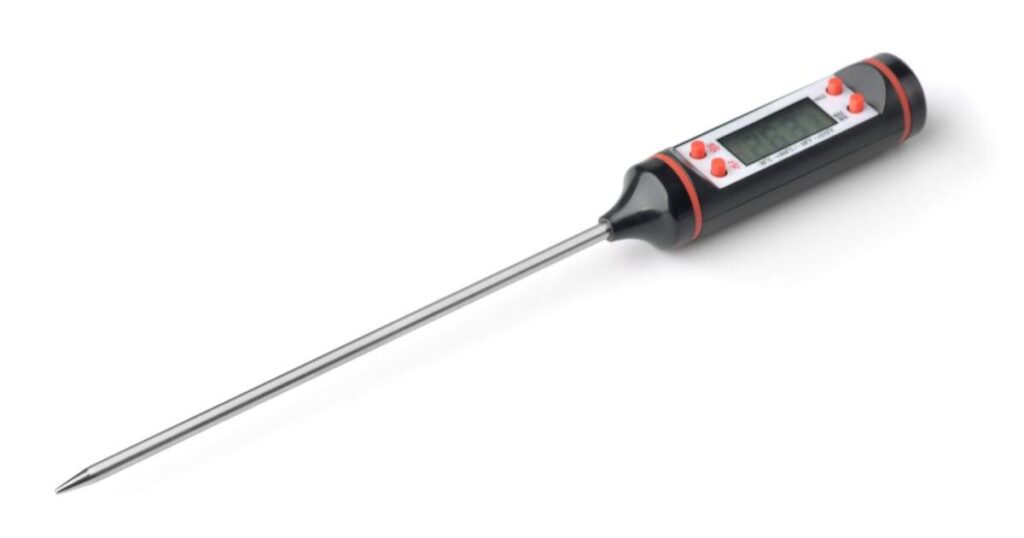
When measuring the internal temperature of meat, several alternative methods are available, each catering to different preferences and cooking techniques. Let’s explore some popular options:
Instant-Read Thermometers
Instant-read thermometers are versatile and widely used in kitchens. They are designed for quick temperature readings and are suitable for various types of meat. To use an instant-read thermometer, insert the probe into the thickest part of the meat and wait for a few seconds until the temperature stabilizes. These thermometers are great for checking the doneness of steaks, burgers, and thin cuts of meat.
Probe Thermometers
Probe thermometers are similar to digital meat thermometers but often come with longer probes. The probe is inserted into the meat, and the display unit remains outside the oven.
Some probe thermometers come with pre-set temperature alarms, alerting you when your meat reaches the desired level of doneness. They are perfect for roasts, whole chickens, and more significant cuts of beef, as you can monitor the temperature without opening the oven door.
Infrared Thermometers
Infrared thermometers are non-contact devices that measure the meat’s surface temperature without penetrating it. They work by detecting the infrared energy emitted by the meat’s surface.
While they don’t provide internal temperature readings, they help check the surface temperature of grills, pans, and other cooking surfaces. Infrared thermometers are convenient for grilling and searing, allowing you to ensure the cooking surface is at the right temperature.
Best Practices for Using a Meat Thermometer
To ensure accurate and reliable temperature readings while using a meat thermometer, consider following these best practices:
Correctly Insert the thermometer: When using a probe-style meat thermometer, insert the probe into the thickest part of the meat, away from bones and fat. Avoid touching the bone for accurate readings, as it can give a false temperature reading and affect the cooking outcome.
Calibrate Regularly: To maintain accuracy, calibrate your meat thermometer regularly. You can do this using the ice water method: Fill a glass with ice cubes, add cold water, and then insert the thermometer probe into the water without touching the sides or bottom. The thermometer should read 32°F (0°C). If it doesn’t, adjust it accordingly.
Respect Safe Cooking Temperatures: Familiarize yourself with safe cooking temperatures for different types of meat. The United States Department of Agriculture (USDA) provides guidelines for safe minimum internal temperatures to avoid foodborne illnesses. Always cook meat to the recommended temperature to ensure it’s safe.
Avoid Cross-Contamination: If you’re using the same meat thermometer for multiple pieces of meat, clean and sanitize the probe between each use. Cross-contamination can spread foodborne bacteria from one part of meat to another, increasing the risk of foodborne illness.
Keep the thermometer Clean: Regularly clean your meat thermometer according to the manufacturer’s instructions. Some thermometers are dishwasher-safe, while others require handwashing. Clean the probe and display unit thoroughly to prevent any residue buildup.
Use the Right Thermometer for the Job: Choose the appropriate type of meat thermometer based on your cooking needs. For quick readings, use an instant-read thermometer for thinner cuts of meat. For larger roasts or whole poultry, opt for a probe-style thermometer.
Minimize Heat Loss: When using a digital meat thermometer with a probe and cable, gently close the oven or grill door around the cord to minimize heat loss. Keeping the door tightly sealed will help maintain a consistent cooking environment.
Rest the Meat. After Cooking: After removing the meat from the heat source, allow it to rest for a few minutes. The temperature will rise slightly during this time, and the juices will redistribute, resulting in a more flavorful and tender dish.
By adhering to these best practices, you’ll ensure the safety of your meals and enhance the quality of your cooking. A meat thermometer is a valuable tool that empowers you to become a more confident and skillful cook, creating delectable dishes that delight and impress all who savor them.
How to Choose a Meat Thermometer
A suitable meat thermometer is crucial to achieving precise and safe cooking results. With various options available on the market, consider the following factors to make an informed decision:
Type of Thermometer: Choose between analog and digital meat thermometers. Analog thermometers are more traditional but are not oven-safe, while digital thermometers with heat-resistant probes are suitable for oven use. Digital thermometers also offer faster and more accurate readings.
Temperature Range: Ensure the thermometer’s temperature range covers the types of meat you commonly cook. Different cores have different optimal cooking temperatures, so having a thermometer with a broad range will cater to your diverse culinary adventures.
Accuracy and Calibration: Look for a thermometer that provides accurate readings. Some thermometers can be calibrated to ensure precision. Regular calibration will maintain accuracy and prevent undercooked or overcooked meals.
Response Time: A quick response time is essential for instant-read thermometers. Faster response times mean less time with the oven or grill open, minimizing heat loss during cooking.
Probe Length: Consider the length of the probe, especially for roasts or more significant cuts of meat. An extended investigation will reach the heart’s center more efficiently, providing accurate readings in thicker cuts.
Display Readability: Opt for a thermometer with a clear and easy-to-read display. A large, backlit display is handy, especially when cooking in low-light conditions.
Ease of Use: Choose a thermometer that is user-friendly and easy to operate. Intuitive controls and a simple interface will make your cooking experience more enjoyable.
Durability and Build Quality: Look for a well-built thermometer from sturdy materials. A durable thermometer will last longer and withstand the rigors of regular use.
Versatility: Consider whether the thermometer can be used for various cooking methods, such as grilling, roasting, or smoking. Versatility ensures that the thermometer remains valuable across different culinary endeavors.
Budget: Determine your budget and find a thermometer that meets your needs within that range. While high-end models may offer more features, excellent thermometers are available at various prices.
How to Calibrate a Meat Thermometer
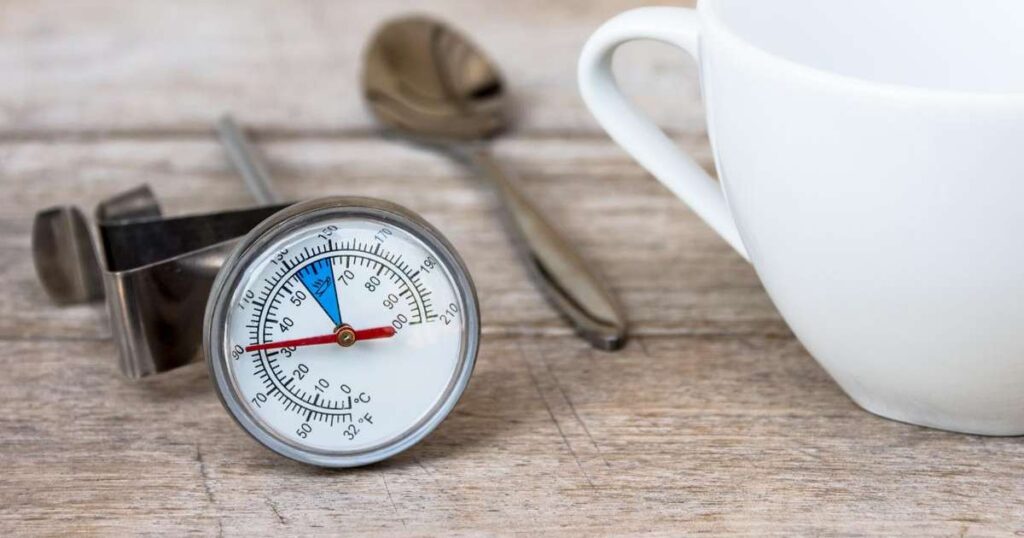
Calibrating a meat thermometer is essential to ensure accurate temperature readings for safe and perfectly cooked meals. Here’s a step-by-step guide to calibrating your thermometer:
Ice Water Method: Fill a glass with ice cubes and add cold water until the glass is full. Stir the water to distribute the temperature evenly.
Insert the Thermometer: Insert the probe of your meat thermometer into the ice water, ensuring it is submerged but not touching the sides or bottom of the glass.
Wait for Stabilization: Allow the thermometer to sit in the ice water for a few minutes until the temperature stabilizes. The thermometer should read 32°F (0°C). If it reads above or below this, it requires calibration.
Calibration Adjustment: If the reading is off, locate the calibration nut or screw on your thermometer. This adjustment mechanism is usually found beneath the dial or near the display. The nut or screw can be turned to adjust the temperature reading.
Calibrate to 32°F (0°C): To calibrate the thermometer, use a wrench or a pair of pliers to gently turn the calibration nut or screw until the display reads 32°F (0°C) for the ice water. Be patient and make minor adjustments until the correct temperature is achieved.
Verify Boiling Water Calibration (Optional): You can also perform a boiling water test for further accuracy. Boil a pot of water and insert the meat thermometer probe into the boiling water, ensuring it doesn’t touch the bottom. At sea level, the thermometer should read 212°F (100°C). Adjust the calibration if needed.
Repeat as Necessary: If your thermometer has freezing and boiling calibration points, perform the above steps to ensure accuracy across the entire temperature range.
How to Clean and Store a Meat Thermometer
Proper cleaning and storage of your meat thermometer are vital to ensure longevity and accurate performance. Follow these steps to keep your thermometer in top-notch condition:
Handwashing the Probe: Most meat thermometers are not dishwasher-safe, so always wash the probe by hand. Use warm, soapy water and a soft cloth or sponge to clean the search thoroughly. Avoid using abrasive materials that could damage the probe’s surface.
Avoid Submerging the Display Unit: If your meat thermometer has a separate display unit, avoid submerging it in water. Instead, use a damp cloth to wipe the display and keep it dry.
Remove Residue Promptly: Clean the probe to remove any food residue or grease after each use. Leaving Residue on the investigation could lead to inaccurate readings and compromise the quality of your cooking.
Sanitize the Probe: To prevent cross-contamination, sanitize the probe before using it on different pieces of meat. You can use a sanitizing solution or wipe the search with a diluted mixture of water and white vinegar.
Store the thermometer Safely: When not used, store the meat thermometer in a safe and dry location. Some thermometers come with protective sheaths or cases for secure storage. Avoid exposing the thermometer to extreme temperatures or direct sunlight.
Secure the Probe Cable: Don’t kink or pinch the cord during storage if your thermometer has a cable connecting the probe to the display unit. Properly secure the line to prevent any damage.
Replace Batteries Regularly: If your meat thermometer uses batteries, replace them as needed. A fresh set of batteries ensures reliable performance and prevents unexpected shutdowns during cooking.
Keep the Calibration in Check: Regularly check the calibration of your meat thermometer to ensure accuracy. If you find any discrepancies, recalibrate the thermometer using the ice water method mentioned earlier.
By following these cleaning and storage practices, you’ll extend the life of your meat thermometer and ensure it remains a valuable tool in your kitchen. A well-maintained thermometer will continue to provide accurate temperature readings, guiding you toward culinary success and culinary delights with every meal you prepare.
Conclusions
A meat thermometer is an indispensable tool in the kitchen, empowering cooks to achieve safe and precise cooking results. Using a digital thermometer rated as oven-safe, you can confidently leave it inside the oven to monitor the meat’s temperature without compromising accuracy. Remember to calibrate your thermometer regularly and follow recommended cooking temperatures for different types of meat.
By incorporating best practices, such as proper cleaning and storage, you can ensure your thermometer remains a reliable kitchen companion for years. With a meat thermometer, you can elevate your cooking skills, serve delectable meals, and create unforgettable dining experiences for yourself and your guests.
FAQs
How long do you leave a meat thermometer in the meat?
The time you leave a meat thermometer in the meat depends on the thermometer type and the meat’s thickness. Getting an accurate reading for instant-read thermometers usually takes a few seconds. However, for probe-style thermometers, especially when dealing with more significant cuts or roasts, you may need to leave it in the meat for a few seconds up to a minute to get a stable reading.
What is an oven-safe thermometer?
An oven-safe thermometer is a type of meat thermometer specifically designed to withstand high oven temperatures. It typically has a heat-resistant probe and a separate display unit outside the oven. This type of thermometer allows you to monitor the internal temperature of the meat without opening the oven door, ensuring precise and safe cooking.
Can you use a meat thermometer while cooking?
Yes, you can use a meat thermometer while cooking. A meat thermometer is highly recommended as it helps you monitor the internal temperature of the meat. It ensures it reaches the minimum temperature required to kill harmful bacteria and guarantees an adequately cooked and safe-to-eat meal.
Can I leave a thermometer in the turkey while baking?
If you have an oven-safe thermometer with a heat-resistant probe, you can leave it in the turkey while baking. However, ensure the probe is positioned correctly in the thickest part of the meat, away from bones, and that the cable (if applicable) is not touching any hot surfaces or heating elements.
How hot can a meat thermometer get?
The maximum temperature a meat thermometer can withstand depends on its design and materials. Most oven-safe digital thermometers can withstand temperatures of up to 400°F (204°C) or more, which is sufficient for most cooking applications. However, it’s essential to check the specific model’s specifications to avoid damaging the thermometer by exceeding its maximum temperature limit.

